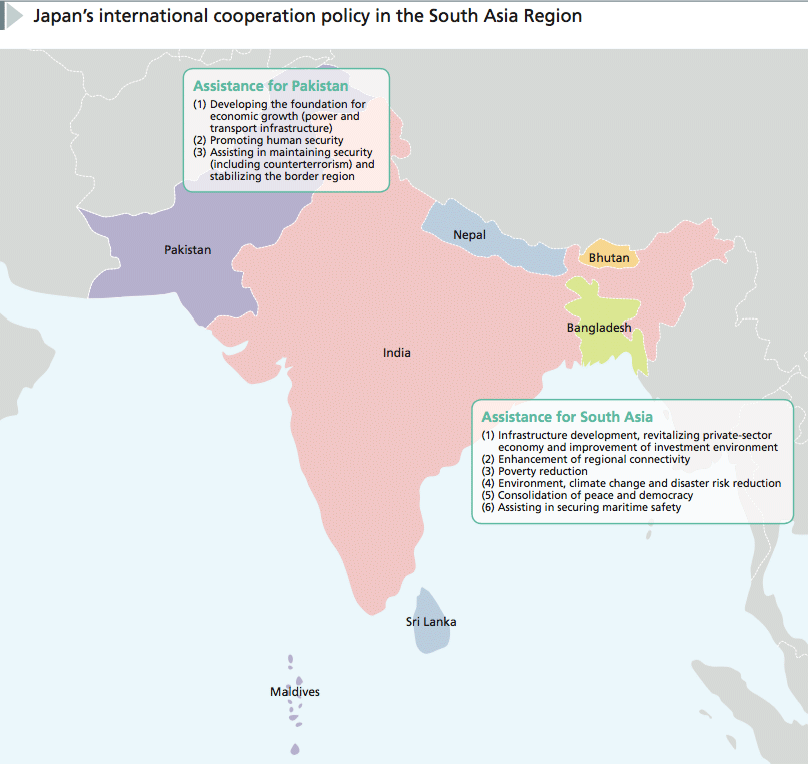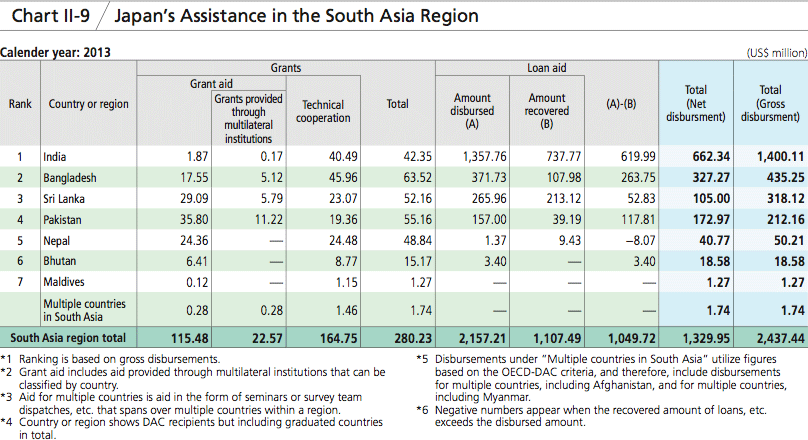2. South Asia
The South Asian region has an enormous economic potential, particularly in India, the world's largest democracy, and has been increasing its presence in the international community. South Asia is strategically important to Japan because of its location on a land route and sea lane that connects East Asia with the Middle East, and is also crucial in terms of addressing global environmental issues. In addition, the region is of great interest to Japan and the rest of the international community in regard to the role it plays in international efforts against terrorism and extremism.
At the same time, the South Asian region still faces many issues that must be addressed. These issues include a severe lack of basic infrastructure such as roads, railroads, and ports, as well as growing populations, low school enrollment ratios in primary education, underdeveloped water and sanitation facilities, inadequate healthcare and medical systems, insufficient maternal and pediatric healthcare, a lack of countermeasures against infectious diseases, and unconsolidated rule of law. Poverty reduction is a particularly challenging problem. Approximately 500 million people among 1.6 billion of the total regional population are said to be living in poverty, making it one of the world's poorest regions. South Asia is the second most important region, behind only Africa, in achieving the Millennium Development Goals (MDGs).(Note 4)
Japan provides assistance with a focus on improving the socio-economic infrastructure in order to harness the economic potential of South Asia as well as to alleviate the growing gap between the rich and the poor.
< Japan's Efforts >
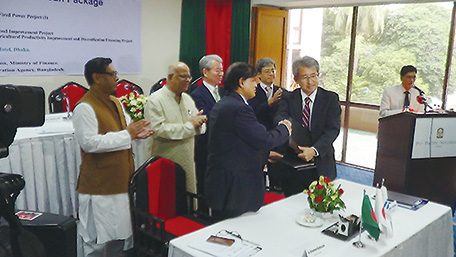
Japan supports future development of Bangladesh under the initiative of the Bay of Bengal Industrial Growth Belt (BIG-B). Officials from Bangladesh expressed gratitude, saying “We have been waiting for this moment for a long time.” (Photo: Hideshi Sasahara / Embassy of Japan in Bangladesh)
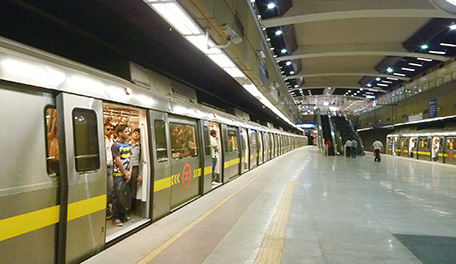
More than a half of the total project cost of the Delhi Metro in India was covered by Japanese ODA loans. The metro now serves as the main transportation for the citizens, and is used by more than 2 million people per day.
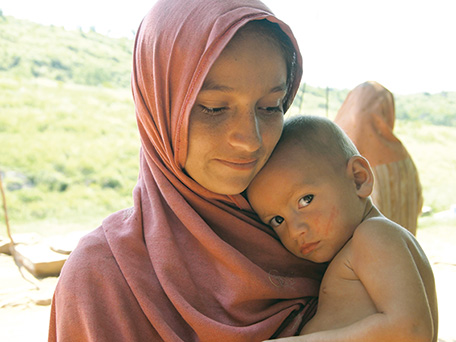
Refugees moved from the border of Afghanistan to Islamabad, the capital city of Pakistan. A girl looking after her young brother. (Photo: Satsuki Arai / Embassy of Japan in Pakistan)
With India, a key player in South Asia, Japan promotes cooperation in a wide range of fields based on the “Special Strategic and Global Partnership.” These include economic cooperation on projects such as the Dedicated Freight Corridor (DFC), which is the backbone of the Delhi Mumbai Industrial Corridor (DMIC) as well as cooperation in the fields of politics and security, economy, and academic exchanges. India has been the largest recipient of Japan's ODA loans in recent years. Japan has provided assistance to India for its development of economic infrastructure, mainly in the field of power and transport, among others. At the Japan-India Summit Meeting during Prime Minister Narendra Modi's visit to Japan in September 2014, Japan expressed its intention to realize ¥3.5 trillion of public and private investment and financing, including ODA, to India over five years. This will be implemented in concert with India's efforts to further improve the business environment. These efforts are aimed at realizing the two countries' common goal of doubling Japan's direct investment in India and the number of Japanese companies in India within five years. Further, Japan engages in social sector development aimed at poverty reduction in India, such as rural development.
With Bangladesh, where there has been remarkable growth and where an increasing number of Japanese companies have been conducting business in recent years, the “Comprehensive Partnership” was launched in May 2014 in the course of a series of mutual VIP visits of the year, namely, Minister for Foreign Affairs Kishida's visit to Bangladesh in March, Prime Minister Sheikh Hasina's visit to Japan in May, and Prime Minister Abe's visit to Bangladesh in September. In May, Japan announced its commitment to provide up to ¥600 billion of assistance to Bangladesh in approximately four or five years from 2014. In the context of deepening the bilateral relations, Japan is strengthening policy dialogue and promoting economic cooperation, mainly under the “Bay of Bengal Industrial Growth Belt” (BIG-B) initiative, whose three pillars are: 1. Developing economic infrastructure in Bangladesh; 2. Improving investment environment; and 3. Fostering connectivity.
In regard to Sri Lanka, to which Prime Minister Shinzo Abe made the first visit as sitting Prime Minister of Japan in 24 years in September 2014, Japan has pledged to enhance bilateral cooperation in the maritime field, as well as to support Sri Lanka's steps towards national reconciliation and efforts towards becoming an upper middle income country, free of poverty by 2020. In view of the deepening and expanding bilateral relations in a range of sectors, Japan will continue to extend cooperation for the development of infrastructure, including transportation and power infrastructure, which will contribute to further economic development in Sri Lanka as well as to improvements in the business environment for Japanese companies operating in the country. Also, in light of the history of internal conflict and the development status of Sri Lanka, Japan will continue to extend cooperation useful for national reconciliation and provide assistance to cope with natural disasters, including livelihood improvement in the emerging regions and industrial development, centering on the agricultural sector.
Pakistan plays a vital role in the international community's initiatives to eradicate terrorism, and Pakistan's cooperation is critically important for the stability of Afghanistan. Japan has thus far implemented $1 billion of assistance pledged at the Pakistan Donors Conference in Tokyo co-hosted by the World Bank in April 2009, and has extended support for Pakistan's efforts in such areas as counter-terrorism and disaster risk reduction. The new Sharif administration that was established in June 2013 identifies as its top priorities the rebuilding of the economy and public finance of Pakistan and the improvement of its security situation. In September 2013, the IMF Executive Board approved a new IMF program (the Extended Fund Facility) for Pakistan (3-year, $6.64 billion). In order to back up Pakistan's reform efforts, Japan also provided ¥5 billion for the Energy Sector Reform Program Loan in June 2014. Through such initiatives, Japan supports the development of socio-economic infrastructure, including electric power, and human security components in Pakistan.
- Note 4: According to the 2014 MDGs Report, the percentage of people living on less than $1.25 per day was 30% (as of 2010), a figure only exceeded by Sub-Saharan Africa.
| Bangladesh
Project for Capacity Development on Natural Disaster-Resistant Techniques of Construction and Retrofitting for Public Buildings
Technical Cooperation Project (March 2011 – Ongoing)
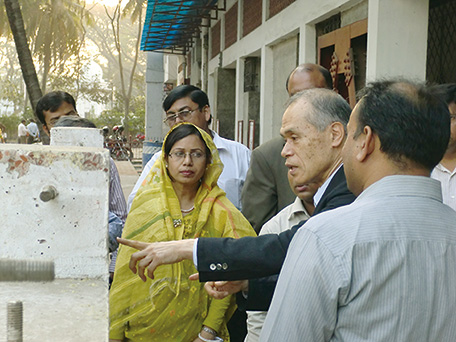
An expert, Mr. Akira Inoue (OYO International Corporation) explaining about the damage on a test specimen for structural testing. (Photo: JICA)
Bangladesh, a country prone to cyclones and flooding, is considered to be at high risk also for earthquake disasters. In recent years, however, in the absence of large-scale earthquakes, people have become less conscious of earthquake resistance. Consequently, most buildings in Bangladesh are not resistant to earthquakes. Some forecast that 70% of the existing buildings will collapse with an earthquake of magnitude 6.5 to 7. It is an imminent task to make public facilities earthquake-resistant, including hospitals, fire stations, schools, and government buildings which will assume important functions in the aftermath of an earthquake.
Japan makes use of its world-leading technologies and draws on its experience in seismic countermeasures to provide assistance to Bangladesh. The assistance is aimed at enhancing the capacity of government agency personnel in seismic-resistant design and construction and improving seismic retrofitting technologies. In this project, activities are undertaken to gauge the current state of the over 5,000 public buildings in Bangladesh, to equip architectural engineers with skills, to establish quality control for design and construction, and to develop construction methods that will make buildings resilient to earthquakes. This project in essence contributes to making public buildings in Bangladesh earthquake-resistant.
In April 2013, a nine-story building in Dhaka suddenly collapsed, although not because of a natural disaster, resulting in the loss of the lives of many people working for the garment factories in the building. The garment industry is a key industry in Bangladesh, accounting for approximately 80% of its exports and employing four million people, mainly women. It is thus an urgent task to improve the safety of garment production facilities. Following this incident, the Japanese government immediately launched a tie-up program with this project to evaluate the seismic capacity of garment factory buildings, to provide long-term low-interest loans for implementing seismic reinforcement and reconstruction work, and to increase the safety of the working environment at garment factories. Government agency personnel who received capacity building training through Japan's technical cooperation will be engaged in the evaluation of seismic capacity and retrofitting design of garment factories, as well as the implementation of actual anti-seismic building measures through loans. It is expected that this will contribute to increasing the safety of garment factories.
(As of August 2014)
